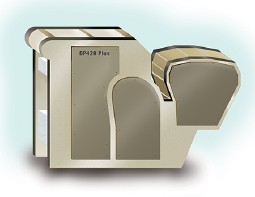More Print Tips
- • Maximum Impact: Is it Best to Send a Postcard or a Letter?
- • Drive Rapid Response to Your Direct Mail: 10 Pro Tips
- • The Usefulness and Utility of Print Marketing
- • Boost Sales with Brochures
- • 5 Opacity Tips You Should Know
- • The Window to Marketing
- • Profitable Postcard Marketing: Finding the Right Frequency
- • 3 Fundamentals for Nailing Your Direct Mail Marketing
- • Picking the Perfect Paper
Nourish Creativity with a Visual Diary
|
Long, drawn-out projects with endless stages and countless revisions can be emotionally and creatively draining. Recharge your creative stores by taking a bit of time every day for pure, no-external-obligation artistic and design endeavors. A visual diary keeps you creative by making a space where you design something new each day that's just for you. Just as a written diary captures your thoughts in words, a visual diary is a place to record your thoughts in a graphical format. It provides a welcome break from your regular work routine and a place for inspiration. |
|
Steps to Succeeding with a Visual Diary |
|
It's easier to begin if you set some parameters. Will you create something daily for a month? Do you prefer to have a theme or to free associate to create? Will you create a paper journal or put your work in a digital format? |
|
Different mediums can inspire different results. For instance, some designers find that working in a graph paper composition book allows them to create well-proportioned designs. |

|
|
Whether you wish to do a small project a day or to dedicate time to your visual journal on three pre-set days a week, sticking to your commitment is important. Regularity is the key. Even 15 minutes a day freely creating can energize you for more in-depth and restricting projects. |
|
Build daily entries into a series. When a subject, medium, or process excites you, explore it further in future entries. You may find that you create an impressive work over time. For instance, you can experiment with different ways to create motion in a graphic or make a typographical piece of art each day. |

|
|
Keep energized by sharing what you're doing. Feedback feeds the creative soul. If you're doing a paper journal, take it with you to gatherings to show friends what you're working on. If your medium for the visual diary is digital, you can share it online through Facebook, Flickr, deviantART, or your own blog. |
|
If you miss a day or two, don't feel tempted to give up on the project altogether. Just pick up where you left off. Don't feel you need to do extra entries to "catch up." The idea is to make this a pleasant commitment. |
|
When the month is over, look over what you've created and store the ideas for later. Your design journals can be a great source of inspiration. When it comes time to start a new design project for work, you may find a solution to design problems in your daily visual journal. |
|
Making visual works for no purpose other than to create can help break up the tedium and stress of a professional creative life. Give yourself permission to create just for you for a short time each day. You'll feel more engaged and better prepared in your professional work. |


Graphic Design Thinking (Design Briefs)
by Ellen Lupton
Creativity is more than an inborn talent; it is a hard-earned skill, and like any other skill, it improves with practice. Graphic Design Thinking: How to Define Problems, Get Ideas, and Create Form explores a variety of informal techniques ranging from quick, seat-of-the-pants approaches to more formal research methods for stimulating fresh thinking, and ultimately arriving at compelling and viable solutions. In the style with which author Ellen has come to been known hands-on, up-close approach to instructional design writing brainstorming techniques are grouped around the three basic phases of the design process: defining the problem, inventing ideas, and creating form. Creative research methods include focus groups, interviewing, brand mapping, and co-design. Each method is explained with a brief narrative text followed by a variety of visual demonstrations and case studies. Also included are discussions with leading professionals, including Art Chantry, Ivan Chermayeff, Jessica Helfand, Steven Heller, Abott Miller, Christoph Niemann, Paula Scher, and Martin Venezky, about how they get ideas and what they do when the well runs dry. The book is directed at working designers, design students, and anyone who wants to apply inventive thought patterns to everyday creative challenges.



Share this